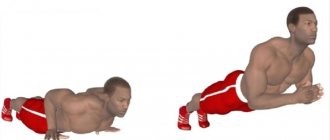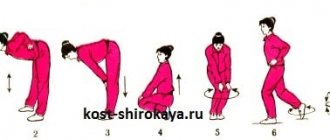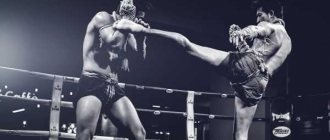Boxing is considered one of the toughest sports, and many prefer it for the opportunity to practice a knockout blow. It is so strong that it will help you defeat your opponent in the ring in a couple of seconds and give a worthy rebuff in a street fight. It is advisable to practice it in sparring, but some exercises can be performed at home. Let's talk in more detail about how to deliver a knockout blow.
1Correct stance
Stand opposite your opponent, turning slightly sideways, with your left side (if you are left-handed, then your right side) towards the person you are fighting. Don't turn completely perpendicular to your torso, just follow your non-dominant leg and hips. This makes you a less easy target and gives you the opportunity to put more force into your punch.
- Maintain a stable position. Do not forget about the center of gravity (if you are right-handed, the main support should be on your right leg, if you are left-handed, then on your left).
- Raise your hands up towards your head, with your non-dominant hand next to your eye and your dominant hand (the one you will be punching with) next to your chin. Your hands should be clenched into a fist so that you can quickly strike or move into defense.
Single mechanism and important points
It is extremely necessary to achieve unity of fist and hand. This is how an effective and punitive mechanism is formed.
To ensure this condition, it is required:
- Keep both your hand and fist in a relaxed state just before hitting the target. As soon as contact occurs, the fist tenses. Such a system sets the desired dynamics and power.
- Avoid arc designs. In other words, the blows follow only a straight line. After all, the impulse is produced from amplifiers, not from a trajectory.
- Do not allow your arms and fist to move back. So expose your intentions to the enemy.
Study all important body points. Hitting them will increase your chances of winning. In the same plane are the following questions: how to learn to punch hard in the face, how to instantly knock out an opponent, how to disorient him, etc.
Aim for these areas. Try to hit them with the strongest blows. On the face, these points are: nose, chin and eyebrows.
Other vulnerable places: temple, ribs, liver, solar plexus.
To improve your performance, learn techniques from other combat disciplines. And your movements will become more mobile and faster, and your attacks will be more flexible and powerful.
Impact block
At this stage, classes are carried out with equipment, weights and fights (first with a shadow, then with a partner).
The list of required activities includes:
- Working with a pear weighing 20-30 kg. Such a projectile does not fly off after the initial impacts. And when working with it, the likelihood of joint damage is low. Hit the bag from the correct stance and using the basics of the striking system.
- Training with dumbbells weighing 2-5 kg. If the shape allows, you can take options for 8-9 kg. Take them in your hands and hit them in the air. This is how strength, endurance and dynamics are developed.
Load on each arm: 10 circles of 12-15 repetitions.
Don't pile up your dominant hand. Instead, focus on developing your weaker hand.
Gradually increase the weight of the apparatus as you become accustomed to the modest weights.
- Shadow fight. Develops attacking dynamics and power. Throw out blows in series, for example 3-4 pieces. And each subsequent one must be stronger than the previous one.
Load – 5 rounds of 3-5 minutes, separated by two-minute pauses.
Practice a variety of strikes and their combinations, for example: jabs with uppercuts, hooks, etc.
You can compete with the shadow while in the pool. The blows follow from the water, overcoming its resistance.
In this fight you can work with dumbbells weighing up to 5 kg. And try to achieve maximum speed.
"From the hip" - hook
From English, hook is translated as hook - a translation, it is worth noting, that describes this sweeping blow as accurately as possible.
A hook refers to the so-called finishing blows, often ending the fight. It is applied with a fist of a hand bent at the elbow.
It can be executed either at the opponent’s body, say, in the liver, or directly at the jaw. It is possible to perform a hook with both hands: only the force of the blow changes.
So, the left hook for a right-hander is weaker, but due to the surprise of the application and the correct placement, it can become a knockout. In this video you can clearly see the hook in action:
First block
All training can be divided into three complexes: developmental, position training and striking. In the first, the necessary parts of the body are strengthened. In the second, correct execution is honed.
The first block includes the following exercises:
- Underwire stand and push-ups on a wooden surface. This involves rolling from one fist to the other. Load – 2-5 minutes or 2 circles of 10-15 repetitions. You can proceed to point two only after completely mastering this exercise.
- Stand on surfaces made of metal, concrete and stone. The load is identical. Duration – 1-2 months daily. If it becomes very difficult, you can reduce the number of classes to 3-4 per week. Only after this can you start step 3
- Lying emphasis. Here the hands are alternately placed behind the back. In this case, you need to stand on one fist. The mining first takes place on a wooden surface, then moves on to iron and concrete.
- Near the wall. Variation 1. Near it you need to stand on your fists, position yourself upside down and raise your legs, and then do push-ups on your fists. Rolling from one fist to another is allowed.
- Near the wall. Variation 2. Here a stand on one fist is performed. The duration is as long as you can.
- Walking on wood with fists for 1-2 weeks, after which the actions take place on concrete and metal.
Gradually after these points the bones will get stronger and become like stone.
Consequences
Every person has the right to self-defense from attacks on his life and health, but with the right comes responsibility.
If the attacker has lost consciousness as a result of your actions or is clearly unable to continue aggression, under no circumstances should you finish him off.
Finishing off a defeated enemy is punishable by Articles 108 and 114 of the Criminal Code of the Russian Federation .
You should leave the scene of the fight as quickly as possible and call the police; you can also tie up the enemy and wait at the scene of the fight for the arrival of law enforcement officers. The only thing you can't do is finish off. And lastly, if the criminal has a knife or any other weapon, you should not engage in battle, it is better to run away, or give him what he demands. Health is more valuable.
Watch a video about how wrestling techniques can be used effectively in a street fight:
Setting up a punch in boxing
The peculiarity of a knockout blow is that it is strong, invisible and delivered as quickly as possible. The goal is to hit the enemy so that he has the strength to continue the fight. A trainer will help you place the kick, but if you wish, special exercises can be performed at home. First, let's look at what a knockout blow is. First, disruption (surprise), then acceleration (strength and speed.)
Disruption
Before striking, the fighter’s head must be cool and all muscles relaxed. His task is to deceive the enemy, to look as if he has no intention of hurting anyone. By the way, you can't knock him out if he's angry. This blow is powerful; when applied, all muscles are involved, since you need to hit not with your hand, but with your whole body. At the same time, you should not allow excessive muscle tension: it may happen that both the speed of the impact and its trajectory change. As a result, the boxer will not hit his opponent, but will fall on top of him.
How to learn to hit sharply? There are several exercises: striking
after sound;
after touching;
on a sheet of newsprint.
After the sound
. It is performed as follows: the boxer takes a fighting stance, the partner stands in a place where he is not visible, and makes some sound, for example, clapping his hands. Upon hearing the sound signal, the boxer must deliver a hard blow. His task is to do this as quickly as possible, so that as little time as possible passes between the sound and the impact. If desired or necessary, make it more difficult: alternate between clapping your hands and using a voice signal.
After touching.
This exercise is similar to the previous one, it’s just that the boxer strikes not after hearing a sound, but after his partner slightly touches him (different parts of the body) or pushes him more noticeably. You need to throw it away as quickly as possible.
On a sheet of newsprint.
The sheet size is 30x30 cm. The partner holds it by the upper corners. The fighter's task is to hit with such speed that the newspaper breaks. This exercise is aerobatics, an ideal that is worth getting closer to.
Finally
Now that it has become clear how hard to punch, you can practice the blow, but not one article or training video will give you the same effect as real training in the gym with a trainer who will control the entire process and guide you on the right path. Constant training and self-improvement can bring you and yours into excellent shape. After which you will feel much more confident on the dark streets of the city, and your body will automatically, without your control, respond to the attacker at a critical moment.
Share with your friends:
Features of self-defense on the street
First of all, you need to remember that the street is not a sports section, no one will follow any sports and moral rules. A street fight, in general, is devoid of any rules.
In addition, the factor of surprise is triggered: a person returning through a dark park does not know from behind which bush a criminal will jump out at him, and when this happens, the strong fear experienced at the moment of the attack prevents him from taking adequate actions. All this leaves its mark on the possibilities of self-defense from attacks.










